#*c: giovanni d'antonio
Text

The Holy Family with the Infant Saint John the Baptist
Artist: Bacchiacca (Italian, 1494 - 1557)
Genre: Religious Art
Francesco d'Ubertino Verdi, called Bachiacca. He is also known as Francesco Ubertini, il Bacchiacca. He was an Italian painter of the Renaissance whose work is characteristic of the Florentine Mannerist style.
Bachiacca was born and baptized in Florence on 1 March 1494 and died there on 5 October 1557
Bachiacca belonged to a family of at least five, and possibly as many as eight artists. His father Ubertino di Bartolomeo (ca. 1446/7-1505) was a goldsmith, his older brother Bartolomeo d'Ubertino Verdi (aka Baccio 1484-c.1526/9) was a painter, and his younger brother Antonio d'Ubertino Verdi (1499–1572)—who also called himself Bachiacca—was both an embroiderer and painter. Francesco's son Carlo di Francesco Verdi (-1569) painted and Antonio's son Bartolomeo d'Antonio Verdi (aka Baccino -1600) worked as an embroiderer. This latter generation probably continued to produce paintings and embroideries after Bachiacca's death and until the Verdi family extinguished about the year 1600.
Bachiacca apprenticed in Perugino's Florentine studio, and by 1515 began to collaborate with Andrea del Sarto, Jacopo Pontormo and Francesco Granacci on the decoration of cassone (chest), spalliera (wainscot), and other painted furnishings for the bedroom of Pierfrancesco Borgherini and Margherita Acciauoli. In 1523, he again participated with Andrea del Sarto, Franciabigio and Pontormo in the decoration of the antechamber of Giovanni Benintendi. While he established a reputation as a painter of predellas and small cabinet pictures, he eventually expanded his output to include large altarpieces, such as the Beheading of St. John the Baptist, now in Berlin.
In 1540, Bachiacca became an artist at the court of Duke Cosimo I de' Medici (reg. 1537-1574) and Duchess Eleanor of Toledo. In this capacity, Bachiacca was a colleague and peer of the most important Florentine artists of the age, including Pontormo, Bronzino, Francesco Salviati, Tribolo, Benvenuto Cellini, Baccio Bandinelli, and his in-law, the sculptor Giovanni Battista del Tasso.
Bachiacca's first major commission was to paint the walls and ceiling of the duke's private study with plants, animals and a landscape, which remain an important testimony of Cosimo's interest in botany and the natural sciences.
#bacchiacca#italian artist#religious art#holy family#christ child#john the baptist#joseph#mary#christianity
2 notes
·
View notes
Text

christ crowned with thorns by antonello di giovanni d'antonio
c. 1470, italian
1 note
·
View note
Text

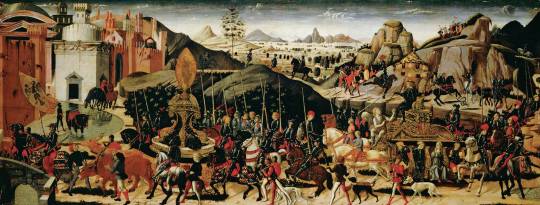

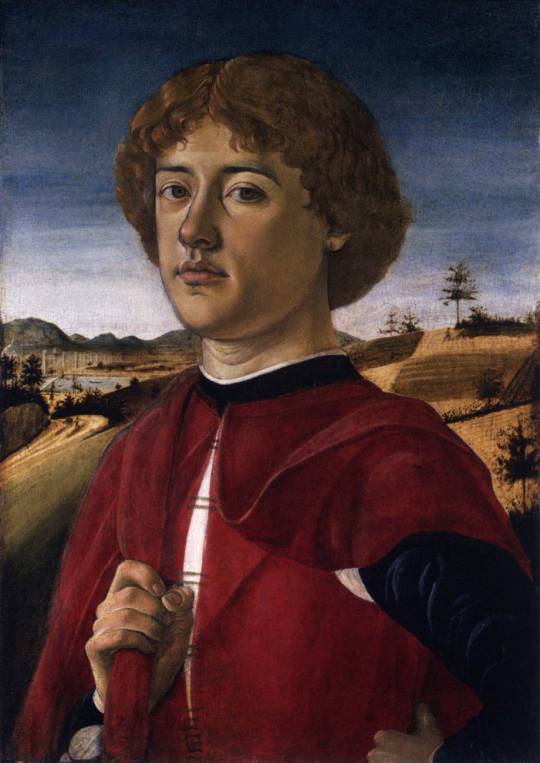

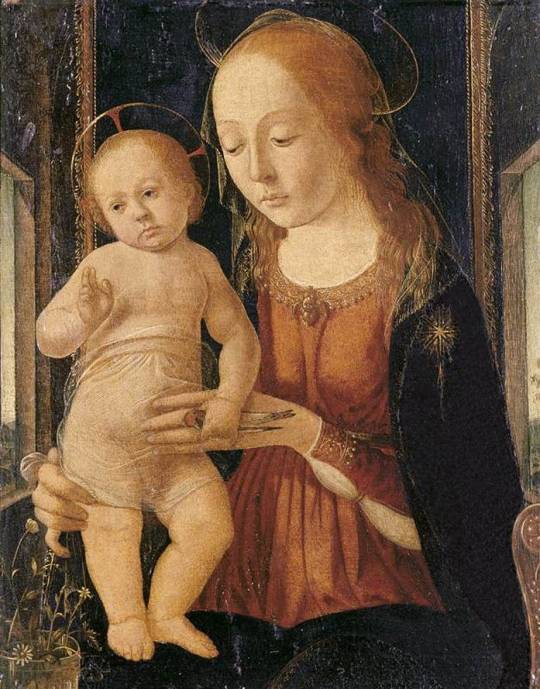



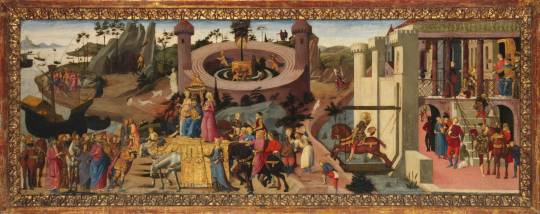

By: Amy Fredrickson
On this day in 1516, Florentine painter Biagio d'Antonio dei Tucci died. He was a prolific artist who was successful both in his native Florence and in other places in Italy; yet, he is often omitted from literature. His works were often confused with, and credited to more renowned artists like Perugino, Botticelli, and Ghirlandaio. Like Biagio, these artists also worked in Rome and decorated the Sistine Chapel during the 1480s. A similar instance occurred with commissions in Faenza, where Biagio was confused with the painters Andrea Utili and Giovanni Battista Utili who, coincidently, also resided in the town and painted cassoni.
As a result, scholars know little about Biagio’s early training. His style exhibits Florentine’s innovations of the late fifteenth-century, such as Fra Fillipo Lippi’s linear style of modeling, Verrocchio’s sculptural influence, and the integration of Netherlandish coloring. Biagio’s connection to Verrocchio is unknown, yet it is confirmed that he collaborated with the painter Cosimo Rosselli in 1470. At this point though, he was a fully trained artist.
Biagio specialized in works for domestic interiors, such as religious panel paintings featuring the Madonna and Child and decorative wedding chests exhibiting biblical and mythological scenes. Biagio favored rich colors that illuminated his subject matter. By 1472, he shared a workshop with Jacopo del Sellaio, with whom he collaborated on cassoni commissions. He established a large studio in Faenza by 1476, which he maintained for about thirty years.
While he was based in Faenza, Biagio traveled to various Italian cities to assist other artists on large commissions. For example, he aided Pietro Perugino with paintings in the Palazzo della Signoria. Then, between 1481 and 1482, he worked with Cosimo Rosselli on frescoes in the Sistine Chapel. Their works included The Last Supper and most likely The Crossing of the Red Sea.
Documents prove that he was still active in 1504 when he painted an altarpiece for the widow of Vincenzo Bazzolini depicting the Madonna and Child with Saints John the Evangelist and Anthony of Padua for the church of San Francesco in Faenza. After 1504, it is unknown whether he had other commissions or if he returned to Florence. Biagio d'Antonio dei Tucci died on June 1, 1516.
References:
"BIAGIO D'antonio Da Firenze In "Dizionario Biografico"". 2019. Treccani.It. http://www.treccani.it/enciclopedia/biagio-d-antonio-da-firenze_(Dizionario-Biografico)/.
Boskovits, Miklós, and David Alan Brown, et al, Italian Paintings of the Fifteenth Century. The Systematic Catalogue of the National Gallery of Art. (Washington, D.C., 2003).
Further Reading:
Bartoli, Roberta, Biagio d'Antonio, (Milan, 1999).
Images:
Virgin and Child Enthroned with Five Saints and Two Angels, 1470-75, Tempera on panel, 168 x 178 cm, Szépművészeti Múzeum, Budapest.
The Triumph of Camillus, 1470-75, Tempera on panel, 60 x 154 cm,
National Gallery of Art, Washington.
Scenes from the Story of Io, 1480s, Tempera on poplar panel, 74 x 133 cm, Private collection.
Portrait of a Young Man, c. 1470, Tempera on wood, 54 x 39 cm, Metropolitan Museum of Art, New York.
Portrait of a Boy, 1476-80, Oil and tempera on panel, 42 x 36 cm, National Gallery of Art, Washington.
Madonna and Child, 1490s, Oil on panel, 45 x 38 cm
Private collection.
Madonna Adoring the Child with an Angel, c. 1475, Tempera on panel, 74 x 54 cm, Museu de Arte, São Paulo.
Crucifixion, 1482, Fresco, Cappella Sistina, Vatican.
Arrest of Christ, 1482, Fresco, Cappella Sistina, Vatican.
Scenes from the Story of the Argonauts, c. 1465, Tempera on wood, gilt ornaments, 50 x 142 cm, Metropolitan Museum of Art, New York.
Chest and spalliera with the arms of Lorenzo Morelli and Vaggia Nerli (The Morelli Chest), 1472, Tempera on panel, The Courtauld Institute of Art, London.
#Italian Renaissance#Florence#Faenza#Rome#fifteenth century#andrea del verrocchio#Pietro Perugino#painting#wall painting#Fresco#biagio d'antonio tucci#Sistine Chapel
31 notes
·
View notes
Text
Alighieri Dante (c. 1265–1321) La Divina Commedia Inferno Canto IV. 118-151 Vita activa & vita contemplativa, Vita contemplativa (130-144), 130-132, 131. Vidi ‘l maestro di color che sanno (Saw maestro of color who know.), Francesco Botticini (Florence, about 1446-1497), Three Archangels with Tobias, circa 1470, Uffizi., Donato Bramante (Italian, 1444–1514), Heraclitus and Democritus, 1477, Pinacoteca di Brera, Milan., Andrea del Verrocchio (Florence, c. 1435–1488) and Leonardo da Vinci (Florence, 1452–Amboise, 1519), The Baptism of Christ, 1472–1475, Uffizi.
Alighieri Dante (c. 1265–1321) La Divina Commedia Inferno Canto IV. 118-151 Vita activa & vita contemplativa, Vita contemplativa (130-144), 130-132, 131. Vidi ‘l maestro di color che sanno (Saw maestro of color who know.), Francesco Botticini (Florence, about 1446-1497), Three Archangels with Tobias, circa 1470, Uffizi., Donato Bramante (Italian, 1444–1514), Heraclitus and Democritus, 1477, Pinacoteca di Brera, Milan., Andrea del Verrocchio (Florence, c. 1435–1488) and Leonardo da Vinci (Florence, 1452–Amboise, 1519), The Baptism of Christ, 1472–1475, Uffizi.
https://blog.naver.com/artnouveau19/222647293928
Alighieri Dante (c. 1265–1321)
La Divina Commedia
Inferno
Canto IV. 118-151
Vita activa & vita contemplativa
Vita contemplativa (130-144): 21 people
Poi ch’innalzai un poco più le ciglia, (After then, I raised a little more eyelashes,)
Vidi ‘l maestro di color che sanno (Saw maestro of color who know.)
Seder tra filosofica famiglia. (He sits among philosophical family.)
Francesco Botticini (Francesco di Giovanni, Florence, about 1446-1497), Assumption of the Virgin, probably about 1475-6, Tempera on wood, 228.6x377.2 cm, National Gallery, London.
https://www.nationalgallery.org.uk/paintings/francesco-botticini-the-assumption-of-the-virgin
Francesco Botticini (Francesco di Giovanni, Florence, 1446-1498), Three Archangels with Tobias, circa 1470, tempera on wood, Height: 135 cm (53.1 in); Width: 154 cm (60.6 in), Uffizi, Florence.
https://commons.wikimedia.org/wiki/File:7_Francesco_Botticini_Three_Archangels_with_Tobias._(135x154cm)_c.1471_Uffizi,_Florence.jpg
In the Light of Angels | Uffizi Galleries
https://www.uffizi.it/en/online-exhibitions/in-the-light-of-angels
Francesco Botticini (real name Francesco di Giovanni, 1446 – 16 January 1498[1]) was an Italian painter of the Early Renaissance. He was born in Florence, where remained active until his death in 1498. Although there are only few documented works by Botticini, a considerable corpus has been confidently attributed to him on the basis of style including a number of altarpieces, dozens of small-scale religious panels and a few portraits.
https://en.wikipedia.org/wiki/Francesco_Botticini
Donato Bramante (Italian, 1444–1514), Heraclitus and Democritus, 1477, fresco transferred to canvas, Height: 102 cm (40.1 in) ; Width: 127 cm (50 in), Pinacoteca di Brera, Milan.
https://commons.wikimedia.org/wiki/File:Donato_Bramante_-_Heraclitus_and_Democritus_-_WGA3054.jpg
https://pinacotecabrera.org/en/collezione-online/opere/heraclitus-and-democritus/
Donato Bramante (UK: /bræˈmænteɪ/ bram-AN-tay,[1] US: /brəˈmɑːnteɪ, -ti/ brə-MAHN-tay, -tee,[2][3] Italian: [doˈnaːto braˈmante]; 1444 – 11 April 1514),[4] born as Donato di Pascuccio d'Antonio[5] and also known as Bramante Lazzari,[6][7] was an Italian architect and painter. He introduced Renaissance architecture to Milan and the High Renaissance style to Rome, where his plan for St. Peter's Basilica formed the basis of design executed by Michelangelo. His Tempietto (San Pietro in Montorio) marked the beginning of the High Renaissance in Rome (1502) when Pope Julius II appointed him to build a sanctuary over the spot where Peter was martyred.
https://en.wikipedia.org/wiki/Donato_Bramante#cite_note-4
Heraclitus
Heraclitus of Ephesus (/ˌhɛrəˈklaɪtəs/;[1] Greek: Ἡράκλειτος Herakleitos, "Glory of Hera"; c. 535 – c. 475 BC,[2] fl. 500 BC)[3][4] was an Ancient Greek, pre-Socratic, Ionian philosopher and a native of the city of Ephesus, which was then part of the Persian Empire.
His paradoxical philosophy and appreciation for wordplay and cryptic utterances has earned him the epithet "The Obscure" since antiquity. He wrote a single work, only fragments of which have survived, increasing the obscurity associated with him. Heraclitus has thus been the subject of numerous interpretations. According to the Stanford Encyclopedia of Philosophy, Heraclitus has been seen as a "material monist or a process philosopher; a scientific cosmologist, a metaphysician and a religious thinker; an empiricist, a rationalist, a mystic; a conventional thinker and a revolutionary; a developer of logic—one who denied the law of non-contradiction; the first genuine philosopher and an anti-intellectual obscurantist."[5]
Heraclitus was of distinguished parentage, but he eschewed his privileged life for a lonely one as a philosopher. Little else is known about his early life and education; he regarded himself as self-taught and a pioneer of wisdom. He was considered a misanthrope who was subject to depression and became known as "the weeping philosopher" in contrast to the ancient philosopher Democritus, who was known as "the laughing philosopher".[6]
Heraclitus believed the world is in accordance with Logos (literally, "word", "reason", or "account") and is ultimately made of fire. He also believed in a unity of opposites and harmony in the world. He was most famous for his insistence on ever-present change—known in philosophy as "flux" or "becoming"—as the characteristic feature of the world; an idea expressed in the sayings, "No man ever steps in the same river twice", and panta rhei ("everything flows"). His use of fire may have been a metaphor for change. This changing aspect of his philosophy is contrasted with that of the ancient philosopher Parmenides, who believed in "being" and in the static nature of the universe. Both Heraclitus and Parmenides had an influence on Plato, who went on to influence all of Western philosophy.
https://en.wikipedia.org/wiki/Heraclitus
Democritus
Democritus (/dɪˈmɒkrɪtəs/; Greek: Δημόκριτος, Dēmókritos, meaning "chosen of the people"; c. 460 – c. 370 BC) was an Ancient Greek pre-Socratic philosopher primarily remembered today for his formulation of an atomic theory of the universe.[3]
Democritus was born in Abdera, Thrace,[4] around 460 BC, although there are disagreements about the exact year. His exact contributions are difficult to disentangle from those of his mentor Leucippus, as they are often mentioned together in texts. Their speculation on atoms, taken from Leucippus, bears a passing and partial resemblance to the 19th-century understanding of atomic structure that has led some to regard Democritus as more of a scientist than other Greek philosophers; however, their ideas rested on very different bases.[5] Largely ignored in ancient Athens, Democritus is said to have been disliked so much by Plato that the latter wished all of his books burned.[6] He was nevertheless well known to his fellow northern-born philosopher Aristotle, and was the teacher of Protagoras.[7]
Many consider Democritus to be the "father of modern science".[8][9] None of his writings have survived; only fragments are known from his vast body of work.
Atomic hypothesis
See also: Atomism
The theory of Democritus held that everything is composed of "atoms," which are physically, but not geometrically, indivisible; that between atoms, there lies empty space; that atoms are indestructible, and have always been and always will be in motion; that there is an infinite number of atoms and of kinds of atoms, which differ in shape and size. Of the mass of atoms, Democritus said, "The more any indivisible exceeds, the heavier it is." However, his exact position on atomic weight is disputed.
https://en.wikipedia.org/wiki/Democritus
Andrea del Verrocchio (/vəˈroʊkioʊ/,[1][2] US also /-ˈrɔːk-/,[3] Italian: [anˈdrɛːa del verˈrɔkkjo]; c. 1435 – 1488), born Andrea di Michele di Francesco de' Cioni, was a sculptor, Italian painter and goldsmith who was a master of an important workshop in Florence. He apparently became known as Verrocchio after the surname of his master, a goldsmith. Few paintings are attributed to him with certainty, but a number of important painters were trained at his workshop. His pupils included Leonardo da Vinci, Pietro Perugino and Lorenzo di Credi. His greatest importance was as a sculptor and his last work, the Equestrian statue of Bartolomeo Colleoni in Venice, is generally accepted as a masterpiece.
https://en.wikipedia.org/wiki/Andrea_del_Verrocchio
Workshop of Andrea del Verrocchio (Florence, c. 1435–1488), Tobias and the Angel, 1470–1480, Egg tempera on poplar, National Gallery, London.
https://en.wikipedia.org/wiki/Tobias_and_the_Angel_(Verrocchio)
https://www.nationalgallery.org.uk/paintings/workshop-of-andrea-del-verrocchio-tobias-and-the-angel
Andrea del Verrocchio (Florence, c. 1435–1488) and Leonardo da Vinci (Florence, 1452–Amboise, France, 1519), The Baptism of Christ, 1472–1475, Oil on wood, 177 cm × 151 cm (70 in × 59 in), Uffizi Gallery, Florence.
https://en.wikipedia.org/wiki/The_Baptism_of_Christ_(Verrocchio_and_Leonardo)
https://www.uffizi.it/en/artworks/verrocchio-leonardo-baptism-of-christ
The Baptism of Christ is a painting finished around 1475 in the studio of the Italian Renaissance painter Andrea del Verrocchio and generally ascribed to him and his pupil Leonardo da Vinci. Some art historians discern the hands of other members of Verrocchio's workshop in the painting as well.
The picture depicts the Baptism of Jesus by John the Baptist as recorded in the Biblical Gospels of Matthew, Mark and Luke. The angel to the left is recorded as having been painted by the youthful Leonardo, a fact which has excited so much special comment and mythology, that the importance and value of the picture as a whole and within the œuvre of Verrocchio is often overlooked. Modern critics also attribute much of the landscape in the background to Leonardo as well.[1] The painting is housed in the Uffizi Gallery in Florence.
https://en.wikipedia.org/wiki/The_Baptism_of_Christ_(Verrocchio_and_Leonardo)
0 notes
Text
FASE 1 DE LA EVALUACIÓN GRUPAL DE HISTORIA
Biografía y lista de obras sobre los arquitectos del texto de Arnold Hauser
Miguel Ángel Bounarroti
Fue un escultor, pintor y arquitecto italiano de los siglos XV y XVI (nació el 6 de marzo de 1475 y murió el 18 de febrero de 1564)
Nació en Caprese, municipio italiano de la provincia de Arezzo, denominado actualmente Caprese Michelangelo en su honor.
Comenzó su formación como pintor a los 12 años en el taller de la familia Ghirlandaio y un año más tarde se adentraría en el mundo de la escultura a través de Bertoldo di Giovanni, el cuál le introduciría en el influyente círculo de los Médici. Desde entonces desarrolló una fructífera vida artística entre Florencia y Roma, de cuyo amplio legado destacan dos grandes obras: El David y la bóveda de la Capilla Sixtina.
Sus últimos años los dedicó a la arquitectura hasta que falleciera en Roma a los 88 años de edad. Algunas de sus obras fueron:
✓Proyecto para la fachada de la Basílica de San Lorenzo de Florencia — 1515–1520
✓La nueva Capilla de los Médici y la Sacristía Nueva de la basílica de San Lorenzo de Florencia — 1520-1534
✓Escalinata y vestíbulo de la Biblioteca Laurenziana, en la basílica de San Lorenzo de Florencia — 1523–1559
✓Biblioteca Laurenziana — 1523–1559 — Florencia
✓Fortificaciones de Florencia — 1528–1529 — Florencia
✓Palacio Farnese — 1546 — Roma
✓Basílica de San Pedro — 1546-1564 — Roma
✓Capilla Sforza en la Basílica de Santa María la Mayor — 1560 — Roma
✓Porta Pia — 1561–1565 — Roma
✓Basílica de Santa Maria degli Angeli e dei Martiri — 1561 — Roma
https://www.buscabiografias.com/biografia/verDetalle/8818/Miguel%20Angel
https://www.saberespractico.com/biografias-resumidas/miguel-angel-buonarroti/
Bramante
Arquitecto y pintor italiano. Donato di Pascuccio d'Antonio o Donato di Angelo di Antonio, conocido como Bramante, fue el mayor arquitecto del Renacimiento italiano, a caballo entre los siglos XV y XVI, heredero de Filippo Brunelleschi y Leon Battista Alberti e inspirador de muchas de las grandes figuras de la arquitectura posterior, de Sansovino a Antonio da Sangallo el Joven.
Nació en el año 1444 en Monte Andruvaldo, cerca de Urbino.
Su padre le inició en el arte de la pintura y del dibujo, mostrando muy pronto una gran predilección por los estudios de perspectivas y del dibujo arquitectónico, conservándose de su obra más temprana los frescos de la fachada del Palacio del Podestà en Bérgamo, realizados en el año 1477.
En 1482 se trasladó a Milán y comenzó su carrera como arquitecto.
En su proyecto para la iglesia de Santa María presso San Satiro (1488, Milán) utilizó por primera vez en la arquitectura el trampantojo en las pinturas del presbiterio fingido, que falsea las proporciones de la iglesia. El resto de sus obras en Milán, como el ábside de Santa María delle Grazie (1492-1495), muestran la influencia de Leon Battista Alberti y sobre todo la de Leonardo da Vinci.
Cuando en 1499 se produjo la caída del duque Ludovico Sforza, huyó a Roma, donde trabajó casi en exclusiva a las órdenes de su nuevo mecenas, el papa Julio II. Una de sus primeras obras romanas es el Tempietto de San Pietro in Montorio (1502), un pequeño templo circular cubierto por una cúpula semiesférica. Los dos grandes proyectos que ocuparon el resto de su actividad creativa, y que no se llevaron a cabo, fueron la reconstrucción de la basílica de San Pedro y el plan para los palacios del Vaticano.
Amigo y protector de Rafael, que le retrató con un compás en la mano en el fresco de la Escuela de Atenas en la estancia de la Segnatura de los palacios vaticanos.
Donato Bramante falleció en Roma el 11 de marzo de 1514.
Entre sus obras podemos citar las siguientes:
✓Santa María presso San Satiro (Milán, 1482 - 1486)
✓Claustro y ábside de Santa María delle Grazie (Milán, 1492 - 1498)
✓Palacio Caprini, o, como también se lo conoce, Casa de Rafael (Roma 1501 - 1502)
✓Templete San Pietro di Montorio (Roma, 1502)
✓Claustro de la iglesia Santa María della Pace (Roma, 1504)
✓Basílica de San Pedro, Ciudad del Vaticano (El diseño es de 1502)
✓Cortile del Belvedere, Ciudad del Vaticano (1506)
https://www.biografiasyvidas.com/biografia/b/bramante.htm
https://es.m.wikipedia.org/wiki/Donato_d%27Angelo_Bramante
Giulio Romano
Giulio di Pietro di Filippo de Gianuzzi fue un pintor, arquitecto y decorador italiano del siglo XVI, prominente alumno de Rafael, cuyas innovaciones en relación al clasicismo del alto Renacimiento ayudaron a definir el estilo definido como manierismo.
Poco se sabe de los orígenes de Giulio Pippi, uno de los más célebres representantes del primer manierismo italiano. Nació en Roma entre 1492 y 1499. Con diez años entró a trabajar en el taller de Rafael, del que en pocos años pasó a ser el colaborador principal. Auxilió al genial artista en la decoración de las Estancias del Vaticano y aunque su trabajo es difícil de discernir en el conjunto del taller rafaelesco, se le atribuye una importante colaboración en la realización de los frescos alusivos a Heliodoro, El incendio del Borgo y Constantino. Entre 1518 y 1519 se encargó, con su maestro, de la decoración de la logia del papa León X en el Vaticano. Giulio se ocupó de trasladar las escenas bíblicas que proyectaba Rafael, y de la dirección de parte de los pintores. Por esta misma época participó junto a su protector en la realización de numerosas obras de caballete. Su primera gran obra personal es la Lapidación de San Esteban (1519-21). A la muerte de Rafael en 1520, Giulio heredó la dirección del taller junto a Francesco Penni. Continuó la decoración de la Sala de Constantino en el Vaticano, para la que realizó la Batalla de Constantino, en que explota las cualidades del clasicismo de Rafael. Los estudios de Giulio para la ocasión revelan un fuerte interés por la arqueología. Al tiempo que realizaba estas obras, se ocupó del diseño de varias villas romanas para clientes de relieve como el Cardenal Julio de Médicis, futuro papa Clemente VII, para quien realizó la villa Madama. Desde 1522 el marqués y duque de Mantua, Federico II Gonzaga, requería sus servicios. En 1524, ante la perspectiva de ser encarcelado por Clemente VII por haber ilustrado los sonetos amorosos del Aretino, Giulio huyó a Mantua. Fue nombrado ministro de obras públicas y colmado de honores, por lo que ya no volvió a salir del ducado. Como fruto de este patronazgo, Giulio se ocupó de todo, construcciones palaciegas como el Palazzo Te o el Ducal, obras de ingeniería y saneamiento, o decorados de teatro y grandes programas decorativos al fresco. Acusó en estos años la influencia de Mantegna, pero, sobre todo, imitó el arte clásico. Plena de manierismo, su pintura destaca por su gran inventiva, su gusto caótico y su afición al ilusionismo en la perspectiva. Sin embargo, será más apreciado por los numerosos dibujos que realizaba como preparación, henchidos de mayor atrevimiento y habilidad técnica.
Falleció en Mantua el 1 de noviembre de 1546. Sus trabajos influirán en otros artistas como Tiziano así como en los autores del clasicismo barroco del siglo XVII.
Algunas de sus obras son:
✓Destacan entre sus obras los frescos sobre la Guerra de Troya y la Historia de Diana, así como los frescos de tema mitológico del Palazzo Te.
✓Logias vaticanas (1519)
✓La Villa Lante (1518 - 1521).
✓El Palacio Stati-Maccarani (1521 - 1524).
✓Palazzo Te (1525-1536)
✓Palacio Thiene (1542-1558)
https://www.artehistoria.com/es/personaje/giulio-romano-pippi-giulio
1 note
·
View note
Photo
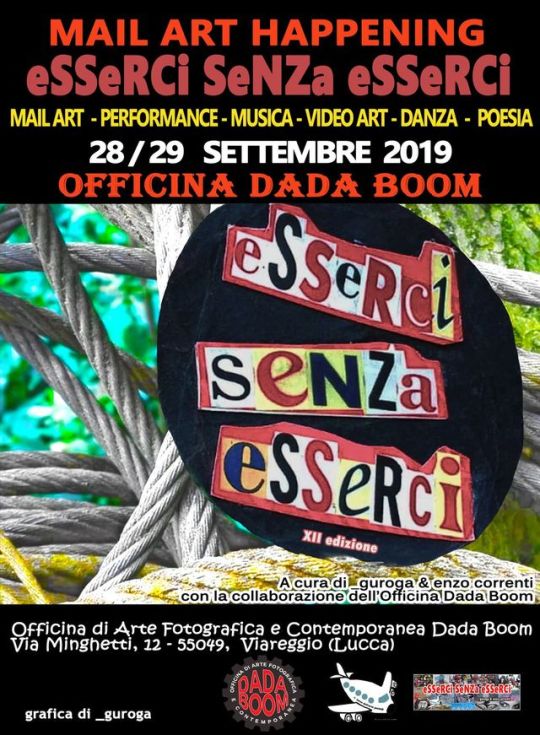
MaiL aRT HaPPeNiNG
eSSeRCi SeNZa eSSeRCi (XII edizione)
Mail art – Performance - Musica - Video Art - Danza - Poesia
-
A cura di _guroga & eNZo CoRReNTi
Con la collaborazione dell’ Officina Dada Boom Viareggio
-
28 / 29 settembre 2019
-
Officina Di Arte Fotografica e Contemporanea Dada Boom
Via Minghetti, 12 – 55049 Viareggio (Lucca)
-
ELENCO ARTISTI PARTECIPANTI (PROVVISORIO)
AGGIORNATO AL 17 SETTEMBRE 2019
01 Daniela Mastromauro (Italia)
02 Eleonora Bianchetti (Italia)
03 Meral Agar (Turchia)
04 Anja Mattila Tolvanen (Finlandia)
05 Turkan Elçi (Turchia)
06-07-30-186 Mimicha Finazzi “Skinaz” (Italia)
08 Alessandro Giannetti (Italia)
09 Lozzo Antifà Egg (Italia)
10-11 Mariano Lo Gerfo (Italia)
12-61 Leti Vanna (Italia)
13-14-15-16 Sassanelli Antonella (Italia)
17-18-62-63-64-100-101-102-126-127 Ina Ripari (Italia)
65-66 artisti vari (Italia)
19-24-25 Antonio Conte (USA-Italia)
20-21 Daniele Virgilio (Italia)
22 Stella Maris verasco (Argentina)
23 Daniel C. Boyer (USA)
26-27-28-29 Giovanni e Renata Strada (Italia)
31-32-33-34 Franco Ballabeni (Italia)
35 Walter Pennacchi (Italia)
36 Monty Cantsin (Canada)
37 Sabela Bana (Spagna)
38-39-40-41 Nestor Rossi (Argentina)
42-43 Mikel Untzilla (Spagna)
44-45-46-47-48-49-50-51-52-53-54-93-94 Serse Luigetti (Italia)
55-56-57-58 Maya Lopez Muro (Argentina-Italia)
59 Janys Oliveira (Brasile)
60-72 Ryosuke Cohen (Giappone)
67 Lancillotto Bellini (Italia)
68 Veit Art _guroga & Enzo Correnti (Venezuela-Italia)
69 Daniela Mastromauro (Italia)
70 Horvàth Piroska (Austria)
71 Claudio Romeo (Italia)
73-74-75-76 Morice Marcuse (Italia)
77-78-79-80-81-82 Roberto Scala (Italia)
83 Girardi Mauro (Italia)
84 Bruno Cassaglia (Italia)
85 Manuel Guillén (Venezuela)
86-87-88-89-90-91-92 Stefano Benedetti (Italia)
95-96 Cherub Ayers (USA)
97 Fernando Calhau (Brasile) busta
98 Meral Agar (Turchia)
99 Bonnie Diva (USA)
103 Mario Selloni (Italia)
104-105-106-107-108-109 Harouna Souare (Guinea)
110-11-112 Beatrice Capozzo (Italia)
113-114-115-116 Maurizio Follin (Italia)
117 Oronzo Liuzzi (Italia)
118 Semenenko Basin (Russia)
119-120 Maria Teresa Cazzaro (Italia)
121 Derya AVCI (Turchia)
122-123-124-125 Stefano Benedetti (Italia)
128 Lancillotto Bellini (Italia)
129-130 Domenico Ferrara Foria (Italia)
131-132 Hikmet Şahin (Turchia)
133-134-135-179-185 Enzo Correnti (Italia)
137-138-139-140 Francesco Cornello (Italia)
141-142-143 Maria Victoria Bone Ramirez (Maritè) Uruguay
146 Giada Mazzini (Italia)
148 Paola Baldassini (Italia)
149 Karla Kolberg Lipp (Brasile)
150 Barbara Ardai & Domenico Mimmo Di Caterino (Italia)
151-152-153-154-155-156-157-158-159-160-161 Mimmo Domenico Di Caterino (Italia)
162 Adele D'Angio (Italia)
163 Dala (Italia)
164-165-166-167 Davide Cruciata (Italia)
168-169 Miguel Jimenez (Spagna)
170 Ina Ripari (Italia)
171-172-173-174 Dania Gentili (Italia)
175-176-177 Mariano Bellarosa (Italia)
178 Enzo Correnti (Italia) & Ivy Junia Grace Wuethrich (Svizzera)
180-181-182-183-184 Ivy Junia Grace Wuethrich (Svizzera)
187-188-189-190-191 Ignazio Fresu (Italia)
193-194-195 Moreno Correnti (Italia)
196-197-198-199-200-201 Noe Itò (Giappone)
202-203 Ksenia Luschi (Italia)
204-205 Fabiola Barna (Italia)
206-207-208 Horst Tress (Germania)
210 Carla Colombo (Italia)
211 Anna Bacchilega (Italia)
212-213 Patrizia Cerella (Italia)
214-215 Antonio Herrera de Hoyos (Messico)
216 I Santini Del Prete (Italia)
217-218 Domenico Severino (Italia)
219 Chiara Burgio (Italia)
220-221 Simona Carletti (Italia)
222-223-224-225-226 Assunta Sabina Preziosi (Italia)
227-228-229-230-239-240-241-243-244-245 Tania Passerino (Italia)
231-232 Vasko Vidmar (Slovenia)
233-234-235 Antonio D'Antonio (Italia)
236 Antonia Valle (Italia)
237-238-239 Sabrina Danielli (Italia)
242 Vittore Baroni (Italia)
246 Simona Giglio (Italia)
247 Claudio Scarpelli (Italia)
248 Tamara Donati (Italia)
249-250 Susanne Schumacher (Germania)
251 Maria Grazia Martina (Italia)
252-253-254-255-271-272 Angela Sardone (Italia)
270 Graziano Dovichi (Italia)
271-272-273-274-275 Angela Sardone (Italia)
277-278-279 Cecilia Chiavistelli (Italia)
280-281 L'alveare che dice si (Italia)
282-283-284-285-286-287-288-289 Luce Fabbri (Italia)
291-292-293 Veit art (_guroga e Enzo Correnti) Venezuela /Italia
293-294-295 Mario Giannelli (Italia)
-
EVENTI COLLATERALI
TRENTATRE PIU’ progetto di Mail art di Antonio Conte
-
WISH I WAS THERE (Vorrei essere lì) progetto collettivo d’archivio di Vittore Baroni
-
Libri della Biblioteca Suphi Nejat Ağırnaslı e Carlo Giuliani
a cura del Museo Popolare della Pineta Viareggio
-
LETTERA AL VIAGGIATORE DEL TEMPO installazione di Davide Cruciata
-
VIDEO ART
_guroga
Giacomo Verde
Gian Luca Cupisti
UN BUCO NELLO STOMACO ( A hole in the stomach) video di Gudrun De Chirico
Lorena Sireno
PROGRAMMA
Sabato, 28 settembre 2019
PICCOLA DESCRIZIONE FORMALE DEL MIO BAGNO
E DELLE PRATICHE DIVINATORIE CHE VENGONO PERSEGUITE IN ESSO
Performance poetica musicale di Eugenio Sanna- chitarra acustica, cellophane, palloncini, lamiere zincate, voce
Giuliano Tremea- voce, lettura, canto
Chiara Lazzerini- trombone, conchiglia
Performance di Laura Serafin
MULIER Performance Ina Ripari e Davide Cruciata
L’INFINITO E LA STORIA Video performance di Mauro Andreani e Paolo Bottari
LA DANZA DELLE STREGHE performance pittorica musicale
Progetto No Name (Sara KO Fontana e Dario Arrighi)
Mort Vivant (Martina Vivaldi)
Giada Matteoli
NO-BODY Performance di Manrico Fiorentini
PROGRAMMA
Domenica, 29 settembre 2019
xxxTITOLOxxx Performance musicale di Lauraballa
NO-FUTURE PUNK Reading di Angela Teodorowsky
Giovanni Colliva al clarinetto basso
con poesie dal Canzoniere della morte di Salvatore Toma
POESIA TOTALE Reading di poesia di Gabriella Beccherelli
POESIE ALLA MANO Reading di poesia di Paolo Guerriero
REO DI METTERCI LA FACCIA Performance di Nicola Bertoglio
QUESTO E’ IL MIO CUORE Performance di Mario Giannelli
Performance di Licia Forlivesi
ESSERCI SENZA ESSERCI Lettura R(3)O Dada di Enzo Correnti e Ivette Berti
DO-MINA DE-SIDERA Performance di Patrizia Cerella e Ina Ripari
Con voce narrante di Paolo Guerriero
Performance di David Brogi
1 note
·
View note
Photo



CAMERINO
These three quattrocento altarpieces are from the Pinacoteca Girolamo di Giovanni, one of the Musei Civici Camerino. Camerino is one of the small cities in the Marche near the epicenters of the earthquakes that inflicted heavy damage on the region’s cultural patrimony in August of 2016 and again in January 2017.
Following rescue protocols established after the earthquakes in Umbria (1997) and Emilia-Romagna (2012), works of art from the museum have been temporarily transferred to conservation facilities and museums outside the area.
1. Giovanni Angelo d'Antonio, Annunciation and Pietà, c. 1455
2. Giovanni Angelo d'Antonio, Virgin and Child Enthroned with Sts. Nicolas of Tolentino and Anthony Abbot, 1449
3. Arcangelo di Cola di Camerino, Virgin and Child Enthroned, 1429
3 notes
·
View notes
Photo





By Jean Marie Carey
On 8 January 1963 the National Gallery of Art in Washington, D.C. set a precedent for the blockbuster museum shows that dominated the rest of the century. The one-painting loan from the Musée du Louvre of Leonardo da Vinci’s The Mona Lisa (c. 1503) drew more than 500,000 visitors through 4 March, when the exhibition moved for another month to the Metropolitan Museum of Art in New York City.
The podcast on the Gallery’s website, “Mona Lisa in Camelot: First Lady Jacqueline Kennedy and the 1963 Exhibition of the Mona Lisa,“by Margaret Leslie Davis recounts the eventful visit.
“This exhibition is no longer on view at the National Gallery,” the NGA’s website drolly notes, but the museum does hold a large number of other paintings by equally notable Italian Renaissance artists.
Reference: Reference: Bülent Atalay. Math and the Mona Lisa: The Art and Science of Leonardo da Vinci. Washington, D.C.: Smithsonian Books, 2004.
First Lady of the United States Jackie Kennedy and French Minister of Culture André Malraux watch President John F. Kennedy give a speech to welcome the Mona Lisa to the National Gallery. Washington, D.C. 1963. Photo: Erich Hartmann.
Fra Angelico and Fra Filippo Lippi. The Adoration of the Magi, c. 1450. National Gallery of Art, Nr. 1952.2.2.
Biagio d'Antonio and Workshop. The Triumph of Camillus, c. 1470. National Gallery of Art, Nr. 1939.1.153.
Masolino da Panicale. The Annunciation, c. 1423. National Gallery of Art, Nr. 1937.1.16.
Benvenuto di Giovanni. The Adoration of the Magi, c. 1475. National Gallery of Art, Nr. 1937.1.10.
Further Reading: Timothy Hyman. Sienese Painting: The Art of a City-Republic (1278-1477). New York, N.Y.: Thames & Hudson 2003.
James H. Beck. Italian Renaissance Painting. Köln: Könemann,1999.
#otd#mona lisa#leonardo da vinci#leonardo#musee du louvre#national gallery of art#jackie kennedy#andré malraux#John F. Kennedy#flotus#potus#washington dc#Benvenuto di Giovanni#Masolino da Panicale#Biagio d'Antonio#Fra Angelico#Fra Filippo Lippi#Margaret Leslie Davis#italy#italian#art#italian art#renaissance#15th century#14th century#20th century
38 notes
·
View notes